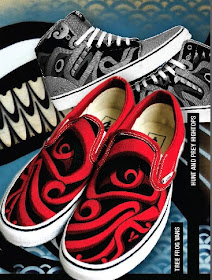Given my commitment to bringing the work of Native writers to the fore--especially those set in the present day--the title alone caught my interest. Seeing names of writers who would have work in Dreaming in Indian intrigued me, too.
I've read it, now, and highly recommend it.
The publisher, Annick Press, tags it as being for young adults. Dreaming in Indian has a vibrancy I've not seen in anything else. A vibrancy that, perhaps, is characteristic of a generation at ease with technology and its tools... Native writers, that is at ease with technology and its use. Here's a set of pages from inside (image from publisher website):
I want to pore over the art, studying it, thinking about it, marveling at it. Isn't it stunning? I can imagine a lot of people dismissing this work because it doesn't conform to their stereotypical ideas of dead or stoic Indians. But I can also imagine a lot of others holding it dear because it reflects who we are...
The Foreword is by Lee Maracle (Salish and Cree Sto:lo Nation). She writes:
All the works in the following pages are part of that amazing struggle to go forward, into modernity, onto the global stage, without leaving our ancient selves behind.And:
They sing out loud in verses, plain and compelling. They cry freedom in words commanding and unapologetic. They do with with tender insistence, bravery, and beauty.Within Native literatures, Maracle's name is up there with our most acclaimed writers. As such, her words mean a lot. One of her most compelling books is I Am Woman: A Native Perspective on Sociology and Feminism.
The first items in Dreaming in Indian are by a younger, equally compelling writer: Nicola Campbell (Interior Salish of Nik7kepmx [Thompson], Nxilx [Okanagan], Metis). I've written about her children's books several times. She has two poems in this book: "I Remember Lullabies" and "I Remember Fried Bologna and Rice." From the red and white checked tablecloth to the smoked hide Auntie works on, Campbell's poems reflect what Maracle noted: modernity and ancient selves that are part of our lives as we go forward.
Campbell's poems are in Part 1: Roots. The theme for Part 2 is Battles; for Part 3 it is Medicine, and Part 4 is titled Dreamcatchers. In each one, you'll find poetry, prose, and all manner of art. For most, you'll also have a solid introduction to the artists and writers, their lives, what drives them... Gritty and real, their live stories are inspiring.
Annick categorizes Dreaming In Indian as nonfiction, but I honestly don't know what to call it. The mix of media, writing, topics... It makes me think of Eliza Dresang and her writing about radical change. There's a lot to ponder in Dreaming In Indian. It'll challenge readers, in good ways, and that is a good thing. Check it out.
Update: Tuesday, September 9, 2:38 PM
I had a query about the image at top of the set of four. It features the work of Louie Gong. He is Nooksack. His contribution to Dreaming In Indian is a panel that has shoes and a phone case on the left:
And, shoes on the right:
The accompanying page says that Gong wanted a pair of Vans but didn't see any patterned ones that he liked. So, he bought some gray ones, went home, and drew traditional Northwest Salish images on them. His art, his expression, his identity. Pretty cool.





Awesome design! I look forward to seeing this in person.
ReplyDeleteAbsolutely beautiful!! Love the creative spirit and how it is transformed into visual art.
ReplyDeleteI wrote my review this morning for our pscreviews.org to be published next month and agree that this is a highly recommended title for all ages.
ReplyDeleteending my remarks with "this is a highly recommended addition to discussion and exploration of identity awareness and self-expression for young adults of any heritage and an antidote to any partitioning of "The Native American Experience" into tragic/historic ghetto mentality. Great for anti-bias/anti-racist discussion, libraries should add and circulate multiple print and eBook copies of this beautiful and significant addition from Canada’s Annick Press. "
Definitely agree, Craig, that libraries should have several copies, and teachers should incorporate it into their teaching year-round.
ReplyDelete